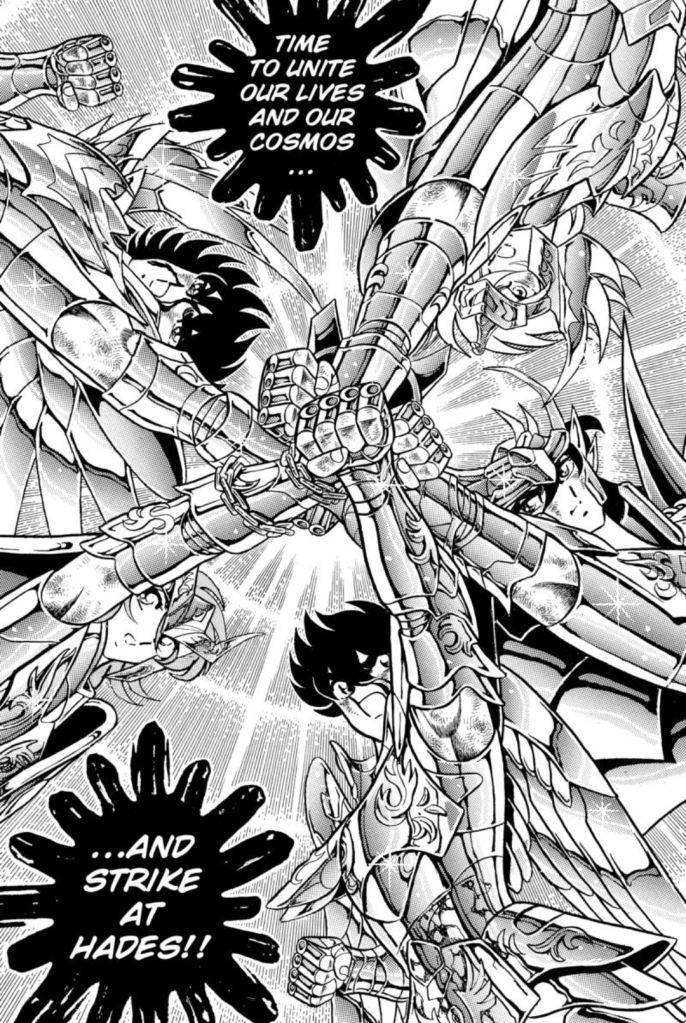
I can finally say that I am hip to the trends of 20th-Century South American anime and manga fandom, as well as other fandoms worldwide. I have continued my reading of the original Saint Seiya all the way to the end, and I now know who the characters are, where their appeal lies, and what makes the series so memorable. At least, I think I do.
Saint Seiya (also known as Knights of the Zodiac) is a 1980s Shounen Jump manga about Seiya, a teen orphan who earns the power of a mystical armor called the Bronze Pegasus Cloth in order to find his missing sister. However, taking this path results in him having to fight rival Saints, before eventually teaming up with them to take on greater threats—including the forces of Greek gods. The series takes a while to find its footing, but once it all coalesces, the result is a work full of passionate pretty boys with intense camaraderie whose many battles take readers through a roller coaster of emotions as one shocking development leads continuously to the next.
It’s very clear to me that the series plays things by ear rather than possessing a more concrete long-term plan. Many seemingly important plot points fall by the wayside, as if the author, Kurumada Masami, wasn’t always sure what Saint Seiya should be. It takes a circuitous path to becoming the tales of Athena’s Saints protecting the Earth, and even after that, many arcs conclude feeling like they might be the last. Characters frequently come back to life or have their armor seemingly irreparably broken only to be restored in some never-before-seen way. According to George Horvath, a big Kurumada fan, the author actually let the readers decide who would join the team, and the series does really feel like it was built in part off fan input in a manner similar to pro wrestling.
But what carries the manga through is just the sheer spectacle and excitement built around its core cast, the Bronze Saint, all of whom have very distinct personalities and appeal. Pegasus Seiya is brave and clever, as is befitting a shounen protagonist. Dragon Shiryu is wise and righteous like a kung fu master. Cygnus Hyoga is cool yet fierce. Andromeda Shun is gentle and compassionate. Phoenix Ikki is headstrong and stoic, his sparse appearances akin to a much less merciless and infinitely more effective Tuxedo Mask who throws traumatic hallucinations instead of roses. Every time one of them gets to shine, their most prominent qualities are on full display and add to the drama of the moment.
One thing that increasingly stood out to me is how every character is extremely willing to sacrifice themselves for others. Again and again, warriors both major and minor try to throw their bodies into the jaws of doom to help save the day. At one point, in what’s called the Poseidon Arc, a critical moment goes from Seiya willing to attack in a way that could cost him his life; to the female character Eagle Marin using her body to shield Seiya; to Seiya trying to shield Marin instead; to Shiryu shielding both; to Shiryu, Hyoga, and Shun forming a wall. It’s a whole lot of wreckless selflessness.
Saint Seiya is the origin of the once-notable “boys in armor” genre, but its reach extends beyond that immediate purview of Samurai Troopers and Brave Command Dagwon. The series is known for being huge with BL fans in the 1980s, and was a major force in the doujinshi scene at that time. It really is no wonder, what with all these fit-looking guys with expressive eyes acting passionate and emotional as they get bloodied and bruised in combat. Without even knowing beforehand, Shun and Shiryu would seem incredibly popular in this regard, the former with his soft and feminine aura, and the latter with his sharp features and long black hair. I don’t know for sure how aware Kurumada was about this fandom, but there are multiple times where Saint Seiya seems to try to get more hetero (are those sparks flying between Seiya and Athena???)—though it always ends up receding into the distance. Call it a template for future works in shounen.
Famously, the manga artist group CLAMP got their start drawing Saint Seiya BL doujinshi. When I think about that fact, I feel like I can tell that the CLAMP aesthetic owes itself in some part to the look of Saint Seiya. Especially in something like RG Veda, the handsome and beautiful characters, the detailed yet confusing full-page attacks, and the general atmosphere evoke the struggles of Seiya and his allies to a certain degree.
Speaking of art style, I know that there is some debate among the fandom about Kurumada’s art style, which tends to be less conventional than the anime adaptation’s character designs. I can see why this divide exists, but I think there’s a certain charm to the manga’s look—an extension of its overall nonstop intensity. Even if the characters’ faces look kind of lopsided, it still carries an energy befitting Saint Seiya.
Although it rushes to wrap up a few dangling plot threads, Saint Seiya ends pretty decisively, making the reading experience satisfying overall. As is the case when I check out big titles from the past, it’s both entertaining and helps give me greater context for both manga history and manga fandom. As both a standalone work and a series that would inspire so much, it stands the test of time.